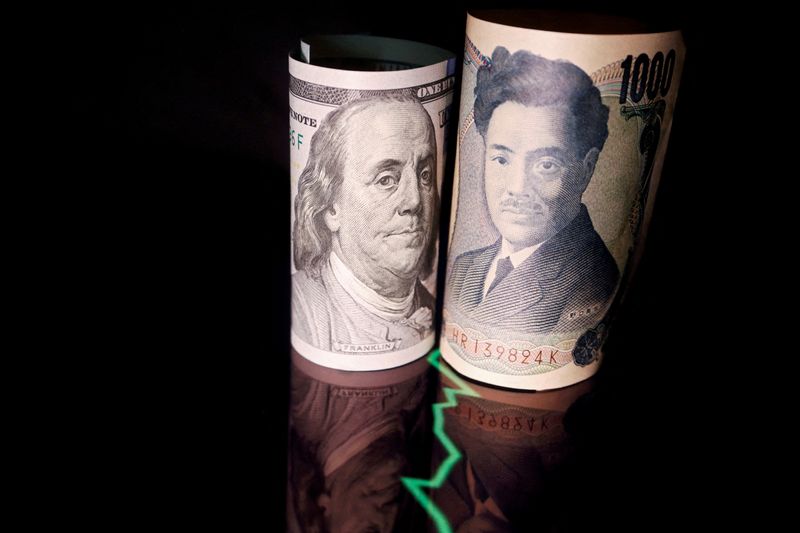
© Reuters. FILE PHOTO: Japanese yen and U.S. dollar banknotes are seen with a currency exchange rate graph in this illustration picture taken June 16, 2022. REUTERS/Florence Lo/Illustration/File Photo
By Rae Wee
SINGAPORE (Reuters) – The dollar was on the back foot on Tuesday, owing to profit taking and pressured in part by a slightly stronger yen as Japanese government officials continued with their jawboning to defend the currency.
Against the greenback, the New Zealand dollar rebounded from a four-month low and last bought $0.5999, and likewise for sterling which firmed to $1.2636, away from last week’s one-month trough of $1.25755.
With a relatively light economic data calendar for the week, the market focus turns to the release of the Federal Reserve’s favoured inflation measure on Friday, which could guide the path of the U.S. interest rate outlook.
The U.S. core personal consumption expenditures (PCE) price index is seen rising 0.3% in February, which would keep the annual pace at 2.8%.
“The Fed Chair has tried to push the market away from aggressive interest rate expectations at the start of this year and he’s always been maintaining the idea that it was going to be a bumpy path,” said Tony Sycamore, a market analyst at IG.
“But a print of 3% (annually) or greater would certainly create a lot of concern that maybe the bumpy path is going to be bumpier than expected.”
A shift in the global rate outlook following a slew of central bank meetings last week had pushed the dollar to a one-month high against its major peers.
While the Fed stuck to its projection of three rate cuts this year, other major central banks similarly signalled that an easing cycle was in play.
“It’s tough for the (dollar) to sustain any weakness with a backdrop in which U.S. growth outstrips growth in the rest of the world,” said Thierry Wizman, global FX and rates strategist at Macquarie. “But it’s even tougher for the (dollar) to weaken when other central banks were sounding more dovish than a dovish Fed.”
Fed officials had on Monday acknowledged an increased sense of caution around the pace of slowdown in inflation in the world’s largest economy.
The was last 0.02% lower at 104.20, while the euro rose 0.03% to $1.0840.
The steadied at $0.6540.
In Japan, the greenback fell 0.04% against the yen to 151.37, facing great resistance near the 152 level due to the threat of intervention from Japanese authorities.
Japanese Finance Minister Shunichi Suzuki on Tuesday said that he would not rule out any measures to cope with the yen’s weakening, echoing a warning from Tokyo’s top currency diplomat the previous day.
The yen has slid more than 1% since the Bank of Japan’s (BOJ) landmark rate hike last week, as traders continue to focus on the still-stark interest rate differentials between Japan and the rest of the world, particularly the United States.
Local authorities have grown increasingly vocal about their discomfort over the currency’s slide, as it nears a multi-decade low that was hit in 2022.
“While they say that the fundamentals don’t justify the price, the market’s telling them something else,” said IG’s Sycamore.
Elsewhere, the rose nearly 0.1% to 7.2487 per dollar, extending its gain from the previous session after suspected selling of dollars by China’s state-owned banks and a strong official guidance set by the central bank, which propped up the currency in the onshore market.


